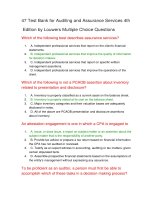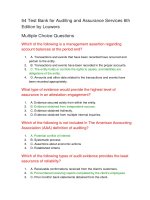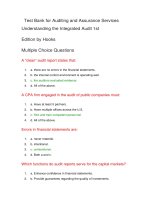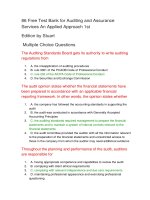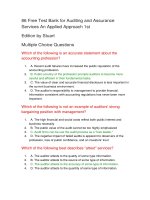Test bank for auditing and assurance services a systematic approach 9th edition messier glover prawitt
Bạn đang xem bản rút gọn của tài liệu. Xem và tải ngay bản đầy đủ của tài liệu tại đây (553.69 KB, 47 trang )
Test Bank for Auditing and Assurance Services : A Systematic Approach 9th Edition Messier, Glover, Prawitt
Test Bank for Auditing and Assurance Services : A
Systematic Approach 9th Edition Messier, Glover, Prawitt
Chapter 01
An Introduction to Assurance and Financial Statement Auditing
True / False Questions
1. Independence standards are required for audits of public companies, but not for audits of private
companies.
True
False
2. Decision makers demand reliable information that is provided by accountants.
True
False
3. Information asymmetry seldom occurs.
True
False
4. Conflicts of interest often occur between absentee owners and managers.
True
False
1-1
Test Bank for Auditing and Assurance Services : A Systematic Approach 9th Edition Messier, Glover, Prawitt
5. Auditing services and attestation services are the same.
True
False
6. Auditing is a type of attest service.
True
False
7. Testing all transactions that occurred during the period is cost prohibitive.
True
False
Multiple Choice Questions
8. Why do auditors generally use a sampling approach to evidence gathering?
A. Auditors are experts and do not need to look at much to know whether the financial statements
are correct or not.
B. Auditors must balance the cost of the audit with the need for precision.
C. Auditors must limit their exposure to their auditee to maintain independence.
D. The auditor's relationship with the auditee is generally adversarial, so the auditor will not have
access to all of the financial information of the company.
9. Which of the following statements best describes a relationship between sample size and other
elements of auditing?
A. If materiality increases, so will the sample size.
B. If the desired level of assurance increases, sample sizes can be smaller.
C. If materiality decreases, sample size will need to increase.
D. There is no relationship between sample size and materiality or the desired level of assurance.
1-2
Test Bank for Auditing and Assurance Services : A Systematic Approach 9th Edition Messier, Glover, Prawitt
10. Which of the following statements about the study of auditing is NOT true?
A. The study of auditing can be valuable to future accountants and business decision makers
whether or not they plan to become auditors.
B. The study of auditing focuses on learning the analytical and logical skills necessary to evaluate
the relevance and reliability of information.
C. The study of auditing focuses on learning the rules, techniques, and computations required to
analyze financial statements.
D. The study of auditing begins with the understanding of a coherent logical framework and
techniques useful for gathering and analyzing evidence about others' assertions.
11. The basic purpose of a financial statement audit is to
A. Detect fraud.
B. Examine individual transactions so that the auditor may certify as to their validity.
C. Provide assurance regarding whether the auditee's financial statements are fairly stated.
D. Assure the consistent application of correct accounting procedures.
12. Assurance services may improve all of the following except
A. Relevance.
B. Credibility.
C. Periodicity.
D. Reliability.
13. Evidence is reliable if it
A. Signals the true state of a management assertion.
B. Applies to the period being audited.
C. Relates to the audit assertion being tested.
D. Is consistent with management's assertions.
1-3
Test Bank for Auditing and Assurance Services : A Systematic Approach 9th Edition Messier, Glover, Prawitt
14. Which of the following best describes the concept of audit risk?
A. The risk of the auditor being sued because of association with an auditee.
B. The risk that the auditor will provide an unqualified opinion on financial statements that are, in
fact, materially misstated.
C. The overall risk that a material misstatement exists in the financial statements.
D. The risk that auditors use audit procedures that are inappropriate.
15. An auditor who accepts an audit engagement and does not possess expertise with respect to the
business entity's industry, should
A. Engage financial experts familiar with the nature of the business entity.
B. Obtain a knowledge of matters that relate to the nature of the entity's business.
C. Refer a substantial portion of the audit to another CPA, who will act as the principal auditor.
D. First inform management that an unqualified opinion cannot be issued.
16. For publicly-held companies, which of the following is integrated into the audit of financial
statements?
A. Budgetary information audit.
B. The audit of internal controls.
C. Audit of management forecasts.
D. Audit of interim financial statements.
17. During the first phase of an audit, a CPA most likely would
A. Identify specific internal control activities that are likely to prevent fraud.
B. Evaluate the reasonableness of the company's accounting estimates.
C. Evaluate the integrity of management.
D. Inquire of the company's attorney as to whether any unrecorded claims are probable or
asserted.
1-4
Test Bank for Auditing and Assurance Services : A Systematic Approach 9th Edition Messier, Glover, Prawitt
18. In the context of agency theory, information asymmetry refers to the idea that
A. Information can vary in its reliability.
B. Information can vary in its relevance.
C. Management has more information about the entity's true financial position than do the
absentee owners (i.e. stockholders).
D. Management likely will not act in the best interests of the absentee owners.
19. Which of the following best describes why an independent auditor is asked to express an opinion
on the fair presentation of financial statements?
A. It is difficult to prepare financial statements that fairly present a company's financial position
and changes in cash flows without the expertise of an independent auditor.
B. It is management's responsibility to seek available independent aid in the appraisal of the
financial information shown in its financial statements.
C. The opinion of an independent party is needed because a company is not likely to be
considered objective with respect to its own financial statements.
D. It is a customary courtesy that all stockholders of a company receive an independent report on
management's stewardship in managing the affairs of the business.
20. Which of the following best describes the fundamental, underlying reason for why there is demand
for an independent auditor to report on financial statements?
A. A management fraud may exist and it is more likely to be detected by auditors if they are
independent.
B. Different interests may exist between the company preparing the statements and the parties
using the statements.
C. A misstatement of account balances may exist and it is the independent auditor's responsibility
to ensure that financial statements are not misstated.
D. A poorly designed internal control system may be in place.
1-5
Test Bank for Auditing and Assurance Services : A Systematic Approach 9th Edition Messier, Glover, Prawitt
21. Which of the following best describes why publicly-traded corporations follow the practice of
having the external auditor appointed by the board of directors or elected by the stockholders?
A. To promote an adversarial relationship between the auditor and the corporation's management.
B. To enhance auditor independence from the management of the corporation.
C. To encourage a policy of rotation of the independent auditors.
D. To give management more leverage over the auditor's decisions.
22. Auditing is defined as a "systematic process of objectively obtaining and evaluating evidence
regarding assertions..." What is meant by "systematic process"?
A. All audits involve obtaining the same evidence.
B. All audits involve evaluating evidence in the same manner.
C. There should be a well-planned approach for obtaining and evaluating evidence.
D. All assertions are equally important for all audits.
23. Which of the following would best be described as an assurance service?
A. Preparing a report representing a client's position during an IRS audit.
B. Working with a company to develop a more efficient method of processing financial
transactions.
C. Offering an opinion concerning the accuracy of statements made on an entity's website relating
to its online privacy policies.
D. Assisting a company in identifying potential sources of capital for potential acquisitions.
1-6
Test Bank for Auditing and Assurance Services : A Systematic Approach 9th Edition Messier, Glover, Prawitt
24. Which of the following statements is not true with respect to assurance, attest, and audit
services?
A. These services are applied only to financial statements and financial statement accounts.
B. These services all involve obtaining and evaluating evidence.
C. These services all involve determining the correspondence of some information to a set of
criteria.
D. These services all involve issuing a report.
25. Auditors are most likely to use the most rigorous audit procedures to examine
A. Routine transactions.
B. Management assertions that are deemed to be of low risk.
C. Only the rights and obligations assertion.
D. Management assertions that are deemed to be of high risk.
26. When obtaining an understanding of the entity and its environment, the auditor should obtain an
understanding of internal controls primarily to
A. Identify areas of relatively high risk of misstatement and plan the audit accordingly.
B. Provide suggestions for improvement to the company.
C. Serve as a basis for setting audit risk and materiality.
D. Decide whether to perform an audit for the company.
27. Which one of the following statements best describes the concept of materiality?
A. Materiality is determined by reference to specific quantitative guidelines established by the
AICPA.
B. Materiality depends only on the dollar amount of an item relative to other items in the financial
statements.
C. Materiality depends on the nature of an item but not on the dollar amount of the item.
D. Materiality is largely a matter of professional judgment.
1-7
Test Bank for Auditing and Assurance Services : A Systematic Approach 9th Edition Messier, Glover, Prawitt
28. Before accepting an engagement to audit a new entity, an auditor is required to
A. Make inquiries of the predecessor auditor.
B. Tell the company whether or not the auditor is willing to issue a "clean" opinion.
C. Prepare a memorandum setting forth the staffing requirements and documenting the
preliminary audit plan.
D. Become a member of the entity's board of directors.
29. An investor is reading the financial statements of the Stankey Corporation and observes that the
statements are accompanied by an auditor's unqualified report. From this, the investor may
conclude that
A. Any disputes over significant accounting issues have been settled to the auditor's satisfaction.
B. The auditor is satisfied that Stankey will be highly profitable in the future.
C. The auditor is certain that Stankey's financial statements have been prepared accurately and
that all account balances are precisely correct.
D. The auditor has determined that Stankey's management is not qualified to lead the company.
30. Preliminary engagement activities include
A. Evaluating internal controls.
B. Assessing audit risk at the account balance level.
C. Setting materiality.
D. Performing background checks on top management.
31. The auditor's report is generally addressed to the
A. Chief operating officer.
B. Securities and Exchange Commission.
C. Stockholders of the company.
D. Chief financial officer.
1-8
Test Bank for Auditing and Assurance Services : A Systematic Approach 9th Edition Messier, Glover, Prawitt
32. An auditor would issue an adverse opinion if
A. The auditor encounters adverse attitudes toward the auditor on the part of company
management.
B. A qualified opinion cannot be given because the auditor is not qualified to do so.
C. An immaterial misstatement is present.
D. The statements taken as a whole do not fairly present the financial condition and results of
operations of the company.
33. Which of the following is true with respect to the auditor's report?
A. The report indicates that the company's financial statements were audited in accordance with
generally accepted accounting standards.
B. The report indicates that the company's financial statements were audited in accordance with
applicable auditing standards.
C. The report indicates that the company's financial statements were audited in accordance with
the auditor's best judgment.
D. The report indicates that the company's financial statements were audited in accordance with
statements issued by the FASB.
34. Which of the following is not a concept that is included in the scope paragraph of the auditor's
report?
A. The conformance of the financial statements with generally accepted accounting principles.
B. The audit was conducted in accordance with applicable auditing standards.
C. The audit was planned and performed to obtain reasonable, rather than absolute, assurance.
D. An audit involves examining items on a test (i.e. sampling) basis.
Short Answer Questions
1-9
Test Bank for Auditing and Assurance Services : A Systematic Approach 9th Edition Messier, Glover, Prawitt
35. On a high level, the accounting processes of a business consist of internal controls, individual
transactions, and account balances.
Required:
A. Describe the relationship between internal controls, individual transactions, and account
balances.
B. Discuss how evidence regarding each of these three areas can help an auditor determine if the
financial statements are fairly stated.
36. Sally Thompson's company, Sally's Shoes, is a successful shoe retail business with one store.
Sally would like to expand to two locations, but the bank has asked for an independent audit
before it will provide financing. Sally hires her brother-in-law, George Thompson, to perform the
audit. George has experience in auditing non-profit organizations and he decides to perform the
audit the same way as his other audits. After completing all the steps of the audit process, George
issues an unqualified opinion indicating that he is certain that the company's financial statements
contain no misstatements. Comment on any potential problems with George's audit of Sally's
Shoes.
1-10
Test Bank for Auditing and Assurance Services : A Systematic Approach 9th Edition Messier, Glover, Prawitt
37. Explain the relationship between audit, attest and assurance services.
38. Define "information asymmetry" and discuss it in the context of the financial markets. Include in
your discussion how information asymmetry is reduced.
39. The textbook presented the concept of auditing through an analogy that involved buying a house
and hiring a house inspector. Name three desirable qualities of a house inspector or an auditor
and discuss how those qualities apply to an auditor and why those qualities are important for an
auditor to possess.
1-11
Test Bank for Auditing and Assurance Services : A Systematic Approach 9th Edition Messier, Glover, Prawitt
40. Discuss an overview of the financial statement audit process using the terms "assertion,"
"evidence," and "report."
41. You are a new employee at the accounting firm Murray & Murray, CPAs. Before you are assigned
to your first audit, your supervisor tests your knowledge and asks you to explain the term "scope"
in the context of a financial statement audit.
Required:
A. Provide a definition of scope.
B. Describe what influences an auditor's determination of scope.
1-12
Test Bank for Auditing and Assurance Services : A Systematic Approach 9th Edition Messier, Glover, Prawitt
42. Why must an auditor assess materiality?
43. You are a new staff auditor and you are auditing a company's inventory account. Briefly describe
one way you might obtain direct evidence and one way you might obtain indirect evidence that the
inventory account balance is fairly stated.
44. Name and discuss the seven phases of the audit process.
1-13
Test Bank for Auditing and Assurance Services : A Systematic Approach 9th Edition Messier, Glover, Prawitt
45. A standard, unqualified auditor's report contains three paragraphs, plus a fourth explanatory
paragraph in some circumstances. Provide a brief (one sentence) description for each paragraph.
46. Explain the relationship between sample size, materiality, and desired level of assurance.
1-14
Test Bank for Auditing and Assurance Services : A Systematic Approach 9th Edition Messier, Glover, Prawitt
Chapter 01 An Introduction to Assurance and Financial Statement
Auditing Answer Key
True / False Questions
1.
Independence standards are required for audits of public companies, but not for audits of
private companies.
FALSE
AACSB: Communication
AICPA BB: Legal
AICPA FN: Decision Making
Blooms: Remember
Difficulty: 1 Easy
Learning Objective: 01-01 Understand why studying auditing can be valuable to you whether or not you plan to become an
auditor; and why it is different from studying accounting.
Topic: Tips for Learning Auditing
2.
Decision makers demand reliable information that is provided by accountants.
TRUE
AACSB: Communication
AICPA BB: Industry
AICPA FN: Decision Making
Blooms: Understand
Difficulty: 1 Easy
Learning Objective: 01-02 Understand the demand for auditing and be able to explain the desired characteristics of auditors and
audit services through an analogy to a house inspector and a house inspection service.
Topic: The Demand for Auditing and Assurance
1-15
Test Bank for Auditing and Assurance Services : A Systematic Approach 9th Edition Messier, Glover, Prawitt
3.
Information asymmetry seldom occurs.
FALSE
AACSB: Communication
AICPA BB: Industry
AICPA FN: Reporting
Blooms: Apply
Difficulty: 2 Medium
Learning Objective: 01-02 Understand the demand for auditing and be able to explain the desired characteristics of auditors and
audit services through an analogy to a house inspector and a house inspection service.
Topic: The Demand for Auditing and Assurance
4.
Conflicts of interest often occur between absentee owners and managers.
TRUE
AACSB: Communication
AICPA BB: Industry
AICPA FN: Reporting
Blooms: Apply
Difficulty: 2 Medium
Learning Objective: 01-02 Understand the demand for auditing and be able to explain the desired characteristics of auditors and
audit services through an analogy to a house inspector and a house inspection service.
Topic: The Demand for Auditing and Assurance
5.
Auditing services and attestation services are the same.
FALSE
AACSB: Communication
AICPA BB: Industry
AICPA FN: Reporting
Blooms: Understand
Difficulty: 1 Easy
Learning Objective: 01-03 Understand the relationships among auditing; attestation; and assurance services.
Topic: Auditing, Attest, and Assurance Services Defined
1-16
Test Bank for Auditing and Assurance Services : A Systematic Approach 9th Edition Messier, Glover, Prawitt
6.
Auditing is a type of attest service.
TRUE
AACSB: Communication
AICPA BB: Industry
AICPA FN: Reporting
Blooms: Understand
Difficulty: 1 Easy
Learning Objective: 01-03 Understand the relationships among auditing; attestation; and assurance services.
Learning Objective: 01-04 Know the basic definition of a financial statement audit.
Topic: Auditing, Attest, and Assurance Services Defined
7.
Testing all transactions that occurred during the period is cost prohibitive.
TRUE
AACSB: Communication
AICPA BB: Critical Thinking
AICPA FN: Decision Making
Blooms: Apply
Difficulty: 2 Medium
Learning Objective: 01-06 Be able to explain why on most audit engagements an auditor tests only a sample of transactions that
occurred.
Topic: Sampling: Inferences Based on Limited Observations
Multiple Choice Questions
1-17
Test Bank for Auditing and Assurance Services : A Systematic Approach 9th Edition Messier, Glover, Prawitt
8.
Why do auditors generally use a sampling approach to evidence gathering?
A. Auditors are experts and do not need to look at much to know whether the financial
statements are correct or not.
B. Auditors must balance the cost of the audit with the need for precision.
C. Auditors must limit their exposure to their auditee to maintain independence.
D. The auditor's relationship with the auditee is generally adversarial, so the auditor will not
have access to all of the financial information of the company.
AACSB: Communication
AICPA BB: Industry
AICPA FN: Decision Making
Blooms: Understand
Difficulty: 1 Easy
Learning Objective: 01-06 Be able to explain why on most audit engagements an auditor tests only a sample of transactions that
occurred.
Topic: Sampling: Inferences Based on Limited Observations
9.
Which of the following statements best describes a relationship between sample size and other
elements of auditing?
A. If materiality increases, so will the sample size.
B. If the desired level of assurance increases, sample sizes can be smaller.
C. If materiality decreases, sample size will need to increase.
D. There is no relationship between sample size and materiality or the desired level of
assurance.
AACSB: Analytic
AICPA BB: Critical Thinking
AICPA FN: Risk Analysis
Blooms: Apply
Difficulty: 2 Medium
Learning Objective: 01-06 Be able to explain why on most audit engagements an auditor tests only a sample of transactions that
occurred.
Topic: Sampling: Inferences Based on Limited Observations
1-18
Test Bank for Auditing and Assurance Services : A Systematic Approach 9th Edition Messier, Glover, Prawitt
10.
Which of the following statements about the study of auditing is NOT true?
A. The study of auditing can be valuable to future accountants and business decision makers
whether or not they plan to become auditors.
B. The study of auditing focuses on learning the analytical and logical skills necessary to
evaluate the relevance and reliability of information.
C. The study of auditing focuses on learning the rules, techniques, and computations required
to analyze financial statements.
D. The study of auditing begins with the understanding of a coherent logical framework and
techniques useful for gathering and analyzing evidence about others' assertions.
AACSB: Communication
AICPA BB: Industry
AICPA FN: Decision Making
Blooms: Analyze
Difficulty: 2 Medium
Learning Objective: 01-01 Understand why studying auditing can be valuable to you whether or not you plan to become an
auditor; and why it is different from studying accounting.
Topic: Tips for Learning Auditing
11.
The basic purpose of a financial statement audit is to
A. Detect fraud.
B. Examine individual transactions so that the auditor may certify as to their validity.
C. Provide assurance regarding whether the auditee's financial statements are fairly stated.
D. Assure the consistent application of correct accounting procedures.
AACSB: Communication
AICPA BB: Critical Thinking
AICPA FN: Reporting
Blooms: Remember
Difficulty: 1 Easy
Learning Objective: 01-03 Understand the relationships among auditing; attestation; and assurance services.
Learning Objective: 01-04 Know the basic definition of a financial statement audit.
Topic: Auditing, Attest, and Assurance Services Defined
1-19
Test Bank for Auditing and Assurance Services : A Systematic Approach 9th Edition Messier, Glover, Prawitt
12.
Assurance services may improve all of the following except
A. Relevance.
B. Credibility.
C. Periodicity.
D. Reliability.
AACSB: Communication
AICPA BB: Industry
AICPA FN: Reporting
Blooms: Remember
Difficulty: 1 Easy
Learning Objective: 01-03 Understand the relationships among auditing; attestation; and assurance services.
Topic: Auditing, Attest, and Assurance Services Defined
13.
Evidence is reliable if it
A. Signals the true state of a management assertion.
B. Applies to the period being audited.
C. Relates to the audit assertion being tested.
D. Is consistent with management's assertions.
AACSB: Analytic
AICPA BB: Critical Thinking
AICPA FN: Measurement
Blooms: Understand
Difficulty: 1 Easy
Learning Objective: 01-05 Understand three fundamental concepts that underlie financial statement auditing.
Topic: Fundamental Concepts in Conducting a Financial Statement Audit
1-20
Test Bank for Auditing and Assurance Services : A Systematic Approach 9th Edition Messier, Glover, Prawitt
14.
Which of the following best describes the concept of audit risk?
A. The risk of the auditor being sued because of association with an auditee.
B. The risk that the auditor will provide an unqualified opinion on financial statements that are,
in fact, materially misstated.
C. The overall risk that a material misstatement exists in the financial statements.
D. The risk that auditors use audit procedures that are inappropriate.
AACSB: Analytic
AICPA BB: Critical Thinking
AICPA FN: Risk Analysis
Blooms: Understand
Difficulty: 2 Medium
Learning Objective: 01-05 Understand three fundamental concepts that underlie financial statement auditing.
Topic: Fundamental Concepts in Conducting a Financial Statement Audit
15.
An auditor who accepts an audit engagement and does not possess expertise with respect to
the business entity's industry, should
A. Engage financial experts familiar with the nature of the business entity.
B. Obtain a knowledge of matters that relate to the nature of the entity's business.
C. Refer a substantial portion of the audit to another CPA, who will act as the principal auditor.
D. First inform management that an unqualified opinion cannot be issued.
AACSB: Ethics
AICPA BB: Industry
AICPA FN: Decision Making
Blooms: Apply
Difficulty: 2 Medium
Learning Objective: 01-07 Be able to describe the basic financial statement auditing process and the phases in which an audit is
carried out.
Learning Objective: 01-09 Understand why auditing demands logic; reasoning; and resourcefulness.
Topic: Logic, Reason, and Resourcefulness
Topic: The Audit Process
1-21
Test Bank for Auditing and Assurance Services : A Systematic Approach 9th Edition Messier, Glover, Prawitt
16.
For publicly-held companies, which of the following is integrated into the audit of financial
statements?
A. Budgetary information audit.
B. The audit of internal controls.
C. Audit of management forecasts.
D. Audit of interim financial statements.
AACSB: Communication
AICPA BB: Legal
AICPA FN: Reporting
Blooms: Remember
Difficulty: 1 Easy
Learning Objective: 01-07 Be able to describe the basic financial statement auditing process and the phases in which an audit is
carried out.
Topic: The Audit Process
17.
During the first phase of an audit, a CPA most likely would
A. Identify specific internal control activities that are likely to prevent fraud.
B. Evaluate the reasonableness of the company's accounting estimates.
C. Evaluate the integrity of management.
D. Inquire of the company's attorney as to whether any unrecorded claims are probable or
asserted.
AACSB: Communication
AICPA BB: Resource Management
AICPA FN: Decision Making
Blooms: Apply
Difficulty: 2 Medium
Learning Objective: 01-07 Be able to describe the basic financial statement auditing process and the phases in which an audit is
carried out.
Topic: The Audit Process
1-22
Test Bank for Auditing and Assurance Services : A Systematic Approach 9th Edition Messier, Glover, Prawitt
18.
In the context of agency theory, information asymmetry refers to the idea that
A. Information can vary in its reliability.
B. Information can vary in its relevance.
C. Management has more information about the entity's true financial position than do the
absentee owners (i.e. stockholders).
D. Management likely will not act in the best interests of the absentee owners.
AACSB: Communication
AICPA BB: Critical Thinking
AICPA FN: Risk Analysis
Blooms: Understand
Difficulty: 1 Easy
Learning Objective: 01-02 Understand the demand for auditing and be able to explain the desired characteristics of auditors and
audit services through an analogy to a house inspector and a house inspection service.
Topic: An Assurance Analogy
Topic: The Demand for Auditing and Assurance
1-23
Test Bank for Auditing and Assurance Services : A Systematic Approach 9th Edition Messier, Glover, Prawitt
19.
Which of the following best describes why an independent auditor is asked to express an
opinion on the fair presentation of financial statements?
A. It is difficult to prepare financial statements that fairly present a company's financial position
and changes in cash flows without the expertise of an independent auditor.
B. It is management's responsibility to seek available independent aid in the appraisal of the
financial information shown in its financial statements.
C. The opinion of an independent party is needed because a company is not likely to be
considered objective with respect to its own financial statements.
D. It is a customary courtesy that all stockholders of a company receive an independent report
on management's stewardship in managing the affairs of the business.
AACSB: Reflective Thinking
AICPA BB: Critical Thinking
AICPA FN: Reporting
Blooms: Apply
Difficulty: 2 Medium
Learning Objective: 01-02 Understand the demand for auditing and be able to explain the desired characteristics of auditors and
audit services through an analogy to a house inspector and a house inspection service.
Topic: An Assurance Analogy
Topic: The Demand for Auditing and Assurance
1-24
Test Bank for Auditing and Assurance Services : A Systematic Approach 9th Edition Messier, Glover, Prawitt
20.
Which of the following best describes the fundamental, underlying reason for why there is
demand for an independent auditor to report on financial statements?
A. A management fraud may exist and it is more likely to be detected by auditors if they are
independent.
B. Different interests may exist between the company preparing the statements and the parties
using the statements.
C. A misstatement of account balances may exist and it is the independent auditor's
responsibility to ensure that financial statements are not misstated.
D. A poorly designed internal control system may be in place.
AACSB: Reflective Thinking
AICPA BB: Critical Thinking
AICPA FN: Reporting
Blooms: Analyze
Difficulty: 2 Medium
Learning Objective: 01-02 Understand the demand for auditing and be able to explain the desired characteristics of auditors and
audit services through an analogy to a house inspector and a house inspection service.
Topic: The Demand for Auditing and Assurance
21.
Which of the following best describes why publicly-traded corporations follow the practice of
having the external auditor appointed by the board of directors or elected by the stockholders?
A. To promote an adversarial relationship between the auditor and the corporation's
management.
B. To enhance auditor independence from the management of the corporation.
C. To encourage a policy of rotation of the independent auditors.
D. To give management more leverage over the auditor's decisions.
AACSB: Ethics
AICPA BB: Legal
AICPA FN: Risk Analysis
Blooms: Analyze
Difficulty: 2 Medium
Learning Objective: 01-02 Understand the demand for auditing and be able to explain the desired characteristics of auditors and
audit services through an analogy to a house inspector and a house inspection service.
Topic: The Demand for Auditing and Assurance
1-25


